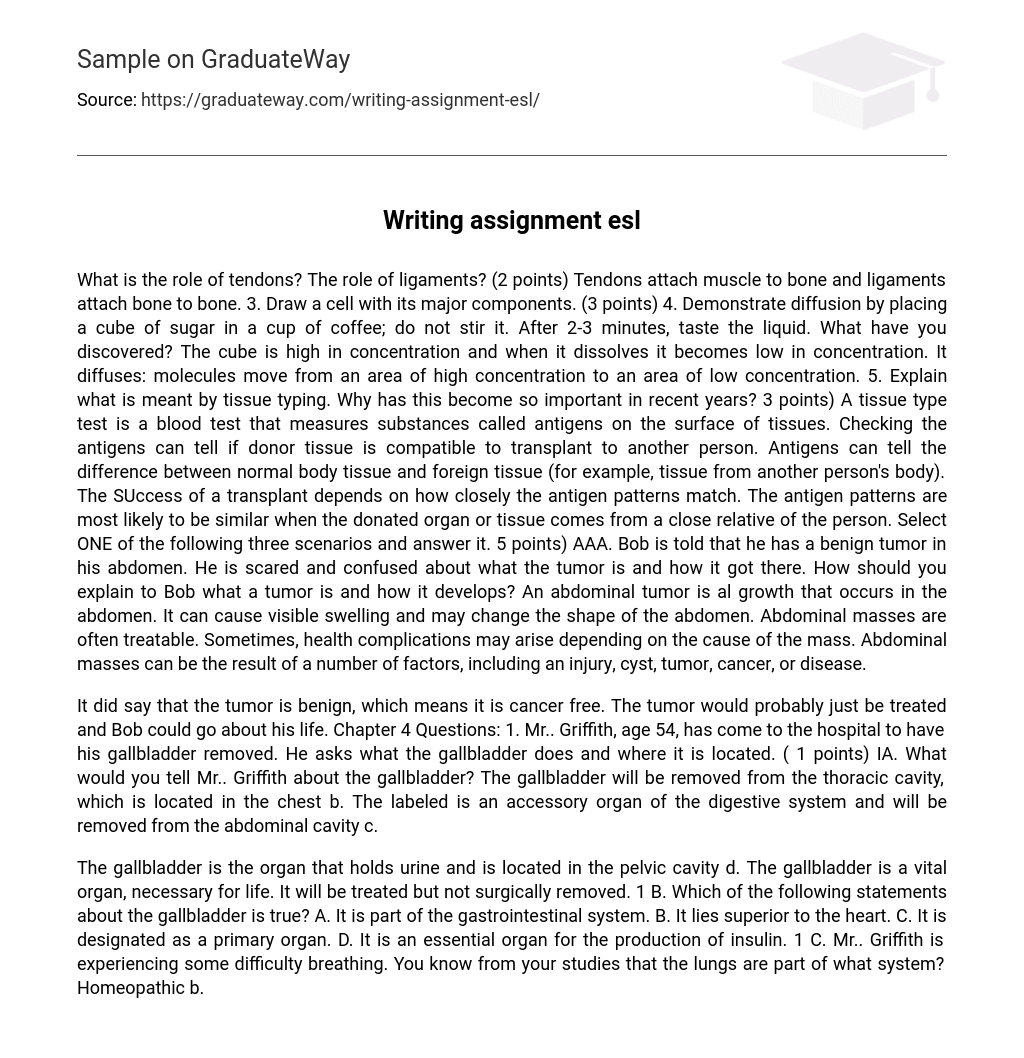What is the role of tendons? The role of ligaments? (2 points) Tendons attach muscle to bone and ligaments attach bone to bone. 3. Draw a cell with its major components. (3 points) 4. Demonstrate diffusion by placing a cube of sugar in a cup of coffee; do not stir it. After 2-3 minutes, taste the liquid. What have you discovered? The cube is high in concentration and when it dissolves it becomes low in concentration. It diffuses: molecules move from an area of high concentration to an area of low concentration. 5. Explain what is meant by tissue typing. Why has this become so important in recent years? 3 points) A tissue type test is a blood test that measures substances called antigens on the surface of tissues. Checking the antigens can tell if donor tissue is compatible to transplant to another person. Antigens can tell the difference between normal body tissue and foreign tissue (for example, tissue from another person’s body). The SUccess of a transplant depends on how closely the antigen patterns match. The antigen patterns are most likely to be similar when the donated organ or tissue comes from a close relative of the person. Select ONE of the following three scenarios and answer it. 5 points) AAA. Bob is told that he has a benign tumor in his abdomen. He is scared and confused about what the tumor is and how it got there. How should you explain to Bob what a tumor is and how it develops? An abdominal tumor is al growth that occurs in the abdomen. It can cause visible swelling and may change the shape of the abdomen. Abdominal masses are often treatable. Sometimes, health complications may arise depending on the cause of the mass. Abdominal masses can be the result of a number of factors, including an injury, cyst, tumor, cancer, or disease.
It did say that the tumor is benign, which means it is cancer free. The tumor would probably just be treated and Bob could go about his life. Chapter 4 Questions: 1. Mr.. Griffith, age 54, has come to the hospital to have his gallbladder removed. He asks what the gallbladder does and where it is located. ( 1 points) IA. What would you tell Mr.. Griffith about the gallbladder? The gallbladder will be removed from the thoracic cavity, which is located in the chest b. The labeled is an accessory organ of the digestive system and will be removed from the abdominal cavity c.
The gallbladder is the organ that holds urine and is located in the pelvic cavity d. The gallbladder is a vital organ, necessary for life. It will be treated but not surgically removed. 1 B. Which of the following statements about the gallbladder is true? A. It is part of the gastrointestinal system. B. It lies superior to the heart. C. It is designated as a primary organ. D. It is an essential organ for the production of insulin. 1 C. Mr.. Griffith is experiencing some difficulty breathing. You know from your studies that the lungs are part of what system? Homeopathic b. Circulatory respiratory endocrine 1 D. Mr.. Griffith mentions that he recently was exposed to poison ivy while fishing. He shows you his arms, which are red and itching. After notifying the appropriate staff member, you remember that the skin is part of which system? Nervous integument 2. To understand the importance of the 11 systems of the body, it is vital that you be able to identify the organs within each system. In the spaces provided, write the names of the organs corresponding to each system.
I would recommend copying and pasting this chart for later use in this class and as we examine each system more in depth this chart should be very useful as a reference tool. (1 5 points) 1. Integument 2. Skeletal 4. Respiratory skin a. Bones nose b. Hair joints pharynx c. Nails . Larynx d. Sense receptors trachea sweat glands e. 3. Muscular bronchi f. Oil glands muscles lungs 5. Digestive: Primary organs 6. Digestive: Accessory organs 7. Nervous mouth teeth brain salivary glands spinal cord . Esophagi c. Tongue c. Nerves stomach liver e. Small intestine gallbladder rectum pancreas .





